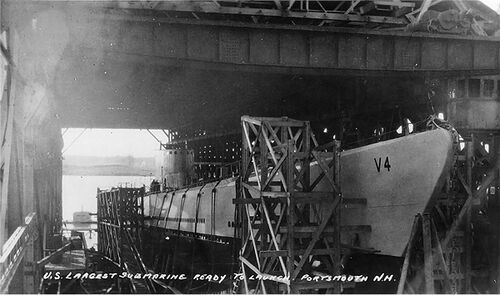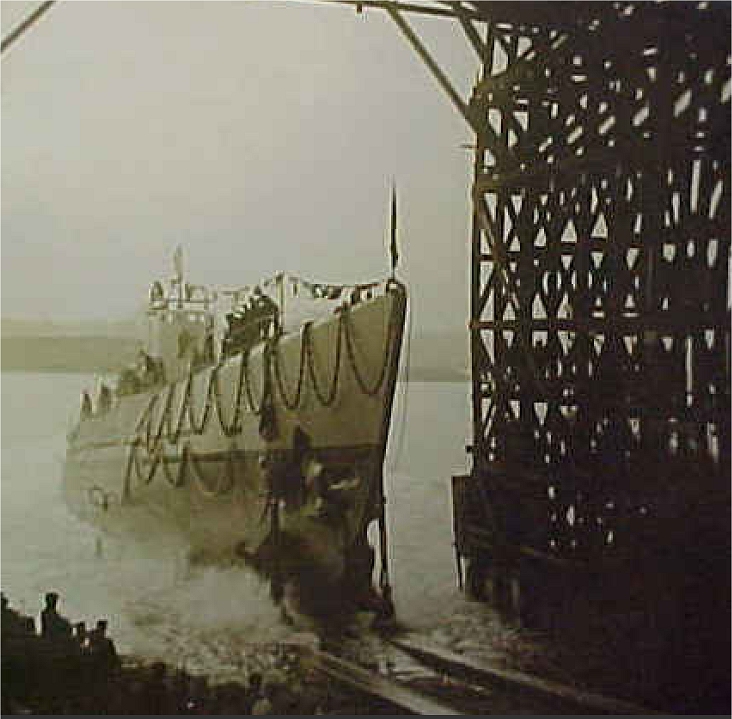V-4
Design, Construction, and Naming Notes
V-4 was a giant. At 381 feet long and a displacement of 3,046 tons submerged her size would not be exceeded by a USN submarine until the nuclear-powered USS Triton (SSRN-586) of 1955. Her great size was dictated by the need to achieve long range. Only a very large submarine would be able to carry the fuel necessary to span the Atlantic and Pacific in search of the enemy's merchantmen. V-4 was also to be equipped with the largest caliber gun ever installed on a USN submarine, two 6"/53 caliber Mk 17 guns, one forward and one aft of the conning tower fairwater in open mounts.
Her great range enabled V-4 to go to an enemy's coastline and lay an effective minefield. The minelaying gear was unique to the boat, and it occupied the after end. Space was provided for sixty huge Mk 11 mines and specialized, automatic, hydraulically operated handling gear. The mines were launched from two large aft facing tubes, and the mines could be laid while the boat was completely submerged. She also was equipped with four 21-inch torpedo tubes forward, with a capacity of 20 Mk 14 torpedoes.
All of the V-boats, but especially the huge V-4, suffered from an underdeveloped diesel engine industrial base in the United States. The industry was still in its infancy in the U.S., and the Navy was forced to rely on license-built derivations of German MAN company designs. The V-4 was definitely underpowered, with her plant consisting of two direct drive 1,400 hp BuEng/MAN main propulsion diesels, and one 450 hp BuEng/MAN generator engine. The Navy specified 15 knots for this boat, and she struggled to make that.
Once commissioned the Navy got a chance to try her out. The minelaying gear proved to be finicky and difficult to maintain. V-4 was a slow diver with sluggish underwater maneuverability and her engines were not reliable. Despite this, the boat provided good service to the fleet during the 1930's. On February 19, 1931 she was renamed Argonaut. For reasons that are not entirely clear, she was never officially redesignated into the general SS series (her hull number would have been 166), and as far as it can be determined she remained designated SM-1 for the rest of her service. Strangely, the authors have uncovered photos of her from the late 1930's that show her with 166 painted on the side of her fairwater. Perhaps it was felt that this was less confusing from a visual identification standpoint, rather than just a large 1.
By the start of the war she was worn out and in need of a thorough overhaul. A early 1942 yard period at Mare Island completely reconditioned the boat, giving her new General Motors engines, air conditioning, a torpedo data computer, radar, longer periscopes, and two aft facing topside torpedo tubes. She arrived back in Pearl Harbor just in time to take part in the Makin Island raid, where her great size enabled her to carry dozens of Marines.
The needs of the war effort forced the Navy to send her on general patrol duties, where her great size and barge-like maneuverability placed her at a disadvantage when dealing with the nimble Japanese destroyers. She made several war patrols before being caught by an IJN anti-submarine force off New Britain. She was sunk in battle to a combined depth charge and gunnery attack. 105 officers and men remain on eternal patrol.

U.S. Navy photo





